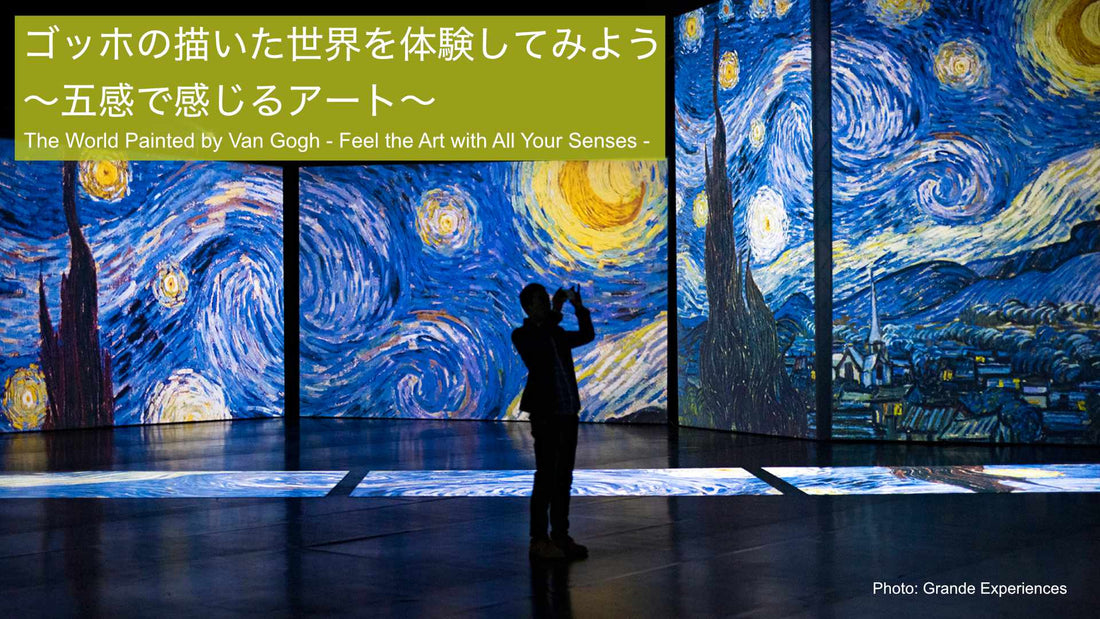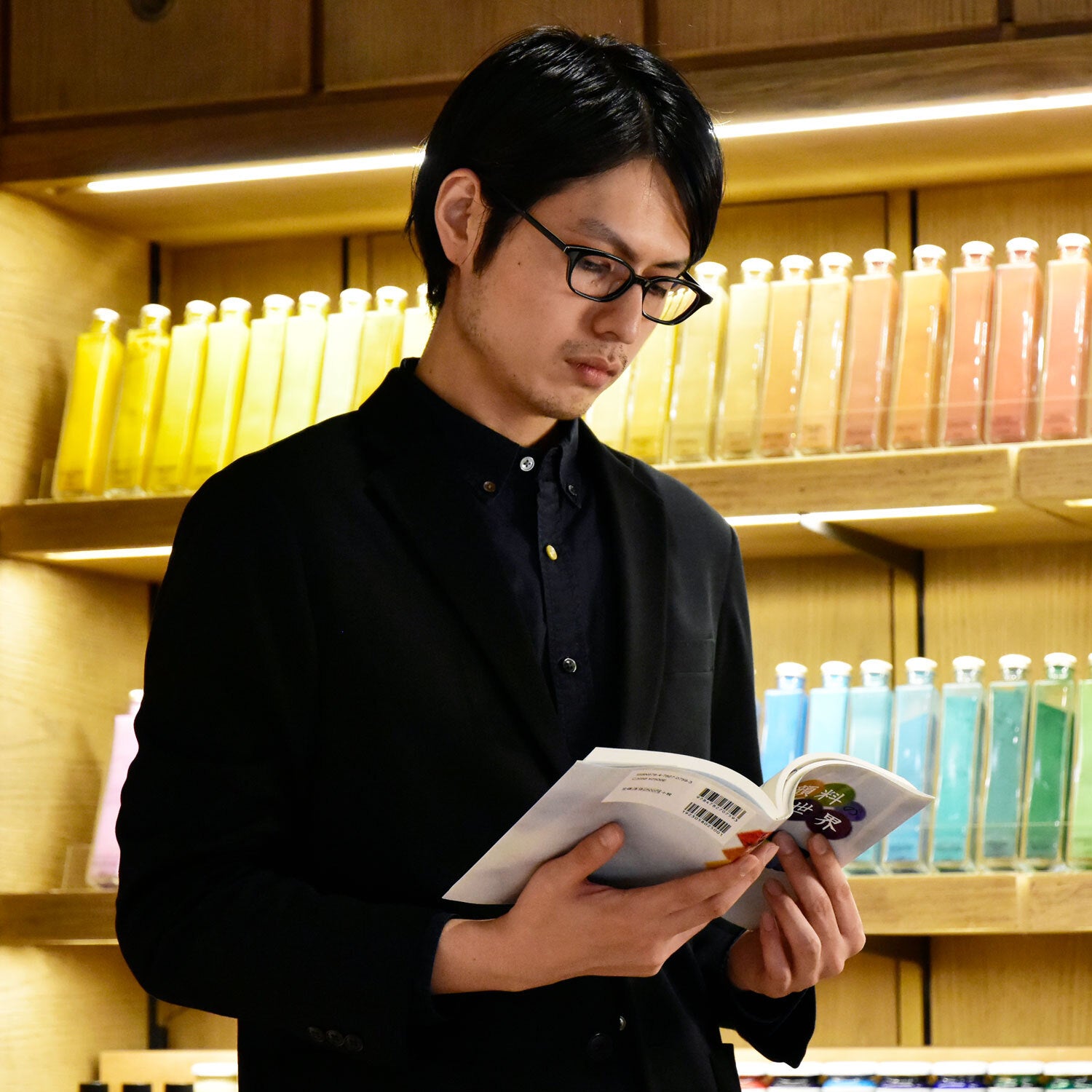From January 6 (Sat.) to March 31 (Sun.) 2024, Warehouse TERRADA will present "Van Gogh Alive," a new immersive exhibition where the audience can experience Van Gogh's world with all our senses. This is a new kind of Van Gogh exhibition in which his paintings are projected on various large walls and floors set up in a huge dark room.
It is an exhibition where visitors can enjoy spectacular art with all five senses.
“Van Gogh Alive" Tokyo Exhibition
(https://goghalivejp.com/tokyo/)
Planning and production: Grande Experiences
Organizer: Van Gogh Alive Tokyo Exhibition Executive Committee
Along with the exhibition, PIGMENT TOKYO has decided to hold a collaborative workshop.

"Van Gogh Alive" exhibition image © RB Create
For those of you living in Tokyo, you may be familiar with one of Van Gogh's most famous paintings, "Sunflowers" as it is preserved in the permanent collection at SOMPO Museum of Art in Shinjuku, Tokyo. Or you may at least have seen it before since the painting often appears in advertisements and other media.
The painting is now part of the museum's collection and it’s known that Van Gogh painted the "Sunflowers" to hang in the studio and living space shared with Paul Gauguin while waiting for his arrival. The following year, while lying on his bed in a hospital in Saint-Rémy, Van Gogh painted "The Bedroom" by thinking of their studio in Arles. This shows how much he loved his studio in Arles.

"Van Gogh Alive" exhibition image Photo: Grande Experiences
The motif, sunflower, also has a special meaning and symbolism in Western painting.
As you know, the sunflower always faces the sun. It represents devotion and loyalty because, in Greek mythology, sunflowers are said to be transformed from a girl who fell in love and broke her heart with Apollo, the king of the sun.
During his stay in Arles, Van Gogh created several still-life paintings of “Sunflowers.”
Did he paint the sunflowers to represent the sun, a symbol of Arles' long, hot summers?
Or did they represent "loyalty to Art" itself? Something about his sunflowers stirs the imagination of viewers like us.

《Sunflowers》1888, Vincent van Gogh, The National Gallery
Another important point when looking at the painting "Sunflowers" is the interrelationship of colors.
For example, in the main visual of "Van Gogh Alive" and "Sunflowers" at the SOMPO Museum of Art, green is used as an accent color in a world where yellow is the main theme.
In "Self-portrait in a Straw Hat" at the Metropolitan Museum of Art, while yellow is the main color, various colors are used all over the painting to enhance the yellow. For example, the base color is brown from the substrate, the shadows on his face are green and his jacket is blue. The way he painted while fully emphasizing the main color, yellow, is just like the color scheme used when coordinating fashion.

《Self-Portrait with a Straw Hat (obverse: The Potato Peeler)》1887, Vincent van Gogh, The Metropolitan Museum of Art
A color wheel is often used to explain color scientifically.
We perceive colors according to their wavelength and the color wheel is a circular arrangement of them.
For example, in the case of "Sunflowers" introduced in this article, orange and yellow are used as the basic colors, while complimentary green is placed to create harmony in the pictorial space. Then, blue lines were added as accent colors.
This technique is also known as "divided brushstroke," a painting technique famously used by Impressionist painters. Even while painting based on the scientific theory of Impressionism, Van Gogh attempted not to focus on the theory too much and to depict the moment when the motif is lively in his paintings.
His wild and vivid colors are characteristic of oil paint.
As the name suggests, oil paints are made by kneading pigments and oil-based mediums. In Van Gogh's time, oil paints in tubes were already carried by stores and when he was in Paris in 1987, he bought his painting materials from the store run by Julien Tanguy. As Van Gogh lovers may have noticed, he is Mr. Tanguy in “Portrait of Père Tanguy.”
Oil paint, the painting medium used by Van Gogh, takes a very long time to dry, which makes it ideal for enjoying the brush marks and mixing colors on the canvas. Visitors are invited to discover colors in the Van Gogh world on the big screens, which can only be experienced in the "Van Gogh Alive" museum.
Just as he incorporated a scientific approach to color into his work, art and science coexist.
For this occasion, PIGMENT TOKYO has planned a workshop inspired by the essence of "Van Gogh Alive."
Along with the effect pigments that sparkle by reflecting light, the other paints that will be used in the workshop are a mixture of pigments that are color powders developed with the modern technology of various manufacturers and water-based acrylic glue. Participants will recreate Van Gogh's masterpiece "The Starry Night" with these paints.
Moreover, this workshop includes a ticker for the "Van Gogh Alive" exhibition in Tokyo.

"Van Gogh Alive" exhibition image. Photo: Grande Experiences
By tracing the swirling night sky with a fine brush, perhaps you would be able to step into Van Gogh's mind and observe how he viewed the world, which is difficult to reach just by looking at his paintings. To help children and those who are not confident in painting, we have prepared a guide sheet with a printed monotone sketch to guide you through the process. Anyone can make a painting just like coloring in a coloring book. The finished artwork can be framed and taken home.
This is an event unique to PIGMENT TOKYO, where visitors can learn about the mechanism of paint, and make a painting with our original paints while experiencing Van Gogh’s world with their own eyes.
Therefore, why not spend a special time, limited to the Tokyo exhibition, by traveling back in time to the night in June 1889 when "The Starry Night" was painted?
・Workshop & Ticket Information

[Limited Time Only]Van Gogh Alive Tokyo Exhibition Special Workshop - Painting "The Starry Night"-
Dates: January 27 (Sat) // February 10 (Sat) & 24 (Sat) // March 9 (Sat) & 23 (Sat), 2024
Time: 14:00 - 16:00
Venue: PIGMENT TOKYO
Fee: ¥10,500 (tax and materials included)
Eligibility: 4th-grade elementary school students and up to adults
Things to bring: None
Reservation:
January 27, 2024 (Saturday)
https://pigment.tokyo/en/products/24-01-27-gogh-ws
February 10, 2024 (Saturday)
https://pigment.tokyo/en/products/24-02-10-gogh-ws
February 24, 2024 (Saturday)
https://pigment.tokyo/en/products/24-02-24-gogh-ws
March 9, 2024 (Saturday)
https://pigment.tokyo/en/products/24-03-09-gogh-ws
March 23, 2024 (Saturday)
https://pigment.tokyo/en/products/24-03-23-gogh-ws
You will receive a free ticket with this workshop, therefore, you can visit the exhibition "Van Gogh Alive Tokyo" at the Warehouse TERRADA G1 Building.
Important Notes About the Tickets for "Van Gogh Alive" in Tokyo
*The museum tickets are valid only on the day of the workshop (you can enter the museum at any time of your choice).
*Please come to PIGMENT TOKYO after 11:00 am on the day of the workshop to pick up your tickets (you cannot pick up your tickets before 11:00 am).
*Adults, university, high school, junior high school, and elementary school students are all eligible to use this ticket.
*We are unable to deliver it in advance.
Translated by Atsumi Okano and Nelson Hor Ee Herng
PIGMENT TOKYO Art Materials Experts



